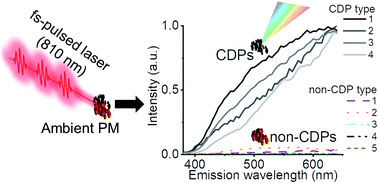Unique emissive behavior of combustion-derived particles under illumination with femtosecond pulsed near-infrared laser light†
Abstract
Exposure to combustion-derived particles (CDPs), such as carbonaceous particulate matter (PM), has adverse effects on human health. Hence, selective detection of these particles in biological environments is required to understand their toxicity. The optical detection of carbonaceous PM is possible in biological samples based on white light (WL) emission under illumination with a femtosecond (fs) pulsed near-infrared (NIR) laser. However, it is unclear if common non-CDPs in ambient PM, such as silica and metal oxides, can interfere with CDP detection when illuminated using a fs-pulsed NIR laser. Here, we show that WL emission, when illuminated with a fs-pulsed NIR laser, is observed only for CDPs amongst other common air pollution particles. We report that the intense WL emission from CDPs spanning over the whole visible spectrum is not observed from non-CDPs. This observation is made for four different CDPs and five different, relevant non-CDPs, in wet and dried samples using biologically relevant imaging conditions. This investigation confirms the uniqueness of WL emission as a selective detection mechanism of CDPs using a multiphoton microscopy platform, commonly available in research laboratories. Furthermore, some relevant signatures for the non-CDPs are provided that could potentially lead to the selective monitoring of pollution related nanoparticles (NPs).

- This article is part of the themed collection: Recent Review Articles


 Please wait while we load your content...
Please wait while we load your content...